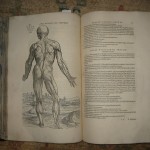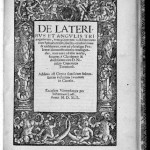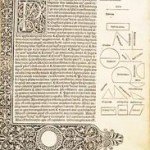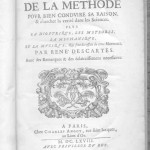In compiling our list of the most significant scientific discoveries published since the second millennium AD (the time period of the invention of the printing press), we primarily considered the significance of the work, while keeping scarcity secondary. What we ended up with are 9 rare books that have something unique to tell us about scientific thought, while their limited supply have collectors searching for significant discoveries of a different kind!
 Philosophiae Naturalis Principia Mathematica. Newton, Sir Isaac. London: Joseph Streater, 1687
Philosophiae Naturalis Principia Mathematica. Newton, Sir Isaac. London: Joseph Streater, 1687
Estimated value: $500,000
Perhaps no other scientific book has changed the thought of man as profoundly as Newton’s magnum opus, the “Principia”. It is generally considered as the most important book within the field of science written by arguably the most influential scientist in human history. The work stands unparalleled in the history of scientific thought, wherein Newton formulated the three laws of motion and the law of universal gravitation.
 De humani corporis fabrica libri septem. Vesalius, Andreas. Basel: Ex Officina Joannis Oporini, 1543
De humani corporis fabrica libri septem. Vesalius, Andreas. Basel: Ex Officina Joannis Oporini, 1543
Estimated value: $400,000
No other work of the sixteenth century equals Fabrica in medical works. Its illustrations were used or copied in other medical works until the end of the eighteenth century. Remarkable series of magnificent plates- woodcut portrait of the author, two double page-size woodcuts (one printed on both sides), and one additional folded leaf with eight woodcuts, 21 full-page woodcuts, 200 smaller woodcuts. It set the new technical standards of anatomical illustration.
 De Lateribus et angulis Triangulorum, tum planorum rectilineorum, tum sphaericorum, libellus eruditissimus & utilissimus, cum ad plerasque Ptolemaei demonstrationes intelligendas.Additus est Canon semissium subtensarum rectarum linearum in circulo. Copernicus, Nicolaus. Wittenberg: Johannes Lufft, 1542
De Lateribus et angulis Triangulorum, tum planorum rectilineorum, tum sphaericorum, libellus eruditissimus & utilissimus, cum ad plerasque Ptolemaei demonstrationes intelligendas.Additus est Canon semissium subtensarum rectarum linearum in circulo. Copernicus, Nicolaus. Wittenberg: Johannes Lufft, 1542
Estimated value: $350,000
Copernicus’ first printed scientific work, containing the first computation of innovative and monumental trigonometric tables.
 Elementa Geometriae. Euclid. Venice: Erchard Ratdolt, 1482.
Elementa Geometriae. Euclid. Venice: Erchard Ratdolt, 1482.
Estimated value: $300,000
One of the earliest printed books with geometrical figures and mathematical text that became a model for subsequent textbook scientific publishing still in common use today. Geometric type metal marginal diagrams throughout.
 Discours de la Methode Pour bien conduire sa raison, & chercher la verité dans les sciences.Plus La Dioptrique. Les Meteors. Et La Geometrie, Qui sont des essays de cete Methode. Descartes, René. Leiden: Jan Maire, 1637.
Discours de la Methode Pour bien conduire sa raison, & chercher la verité dans les sciences.Plus La Dioptrique. Les Meteors. Et La Geometrie, Qui sont des essays de cete Methode. Descartes, René. Leiden: Jan Maire, 1637.
Estimated value: $150,000
The Discours presents the outline of Cartesian scientific method in the form of a preface to three practival treasies: La Dioptrique, which includes Descartes’s derivation of the law of refraction; Les Meteors, meteorology concerns regarding wind, clouds, rain, rainbows, snow, lightning ; and La Geometrie, his application of algebra to geometry. Numerous woodcut diagrams in the text (one full-page repeated seven times).
 On the Origin of Species by Means of Natural Selection, or the Preservation of Favoured Races in the Struggle for Life. Darwin Charles. London: John Murray 1859.
On the Origin of Species by Means of Natural Selection, or the Preservation of Favoured Races in the Struggle for Life. Darwin Charles. London: John Murray 1859.
Estimated value: $150,000
Arguably, one of the most influential seminal works of the nineteenth century describes Darwin’s theory of evolution by natural selection. It describes the theory of the workings of organic nature through constant change, in order to establish the order of the universe. One folded lithographic diagram by William West.
 Opticks: or, a Treatise of the Reflexions, Refractions, Inflexions & Colours of Light. Newton, Sir Isaac. London: Sam Smith & Benj. Walford, 1704.
Opticks: or, a Treatise of the Reflexions, Refractions, Inflexions & Colours of Light. Newton, Sir Isaac. London: Sam Smith & Benj. Walford, 1704.
Estimated value: $60,000
Pioneering studies of light and the solar spectrum, the first workable theory of the rainbow, and experiments on what later would be called interference effects in conjunction with Newton’s rings. It led to the invention of a refracting telescope, which uses a converging mirror rather than a combination of lenses. With 19 folding engraved plates.
“De Viribus Electricitatis In Motu Musculari Commentarius”, in De Bononiensi Scientarium et Artium Instituto atque Academia
Commentarii, volume VII pages 316-418. Galvani, Luigi. Bologna: Typographia Instituti Scieniarum, 1791.
Estimated value: $50,000
Classic paper of electrophysiology, exhibiting that electric current could produce measurable biologic phenomena. Using frogs, Galvani discovered that muscles contract once exposed to electric discharge. We still referred to the action of being “galvanized” today. Contains four folding engraved plates by Jacopo Zambelli.
Horologium oscillatorium sive de motu pendulorum ad horologia aptato demonstrationes geometricae. Huygens, Christian. Paris: F. Muguet, 1673
Estimated value: $50,000
This work contains the first mathematical analysis of the pendulum, consideration of motion of bodies along curved paths, and theorems on centrifugal forces which were instrumental in Newton’s formulation of the law of universal gravitation. Probably the greatest advancement to physics. It was from Galileo that Huygens (1629-95) learned of the isochronisms of the pendulum. Numerous woodcuts.
{ 0 comments… add one now }
{ 1 trackback }